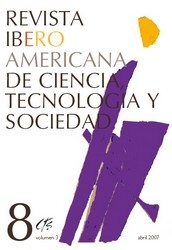Researcher Mobility and Co-authored Production for the Study of Scientific Collaboration
DOI:
https://doi.org/10.52712/issn.1850-0013-942Keywords:
scientific mobility, production in coauthorshipAbstract
The mobility of researchers is considered a central element of the scientific collaboration. We propose to study its characteristics and its relation with the publication production in coauthorship in a specific institution in order to analyze if the “profiles of collaboration” measured through mobility and the production in coauthorship, are similar. The subject of the present study is the University Carlos III of Madrid, period 1998-2003. We use as sources the Annual Report of tne University together with bibliographic databases: the international databases of Thomson-ISI (SCI, SSCI, A&HCI) and the Spanish databases of CSIC (ICYT, IME and ISOC). The results show a relationship between mobility and production in collaboration and induce us to undertake new studies on the impact of mobility in the global scientific activity.
Downloads
References
BORDONS, María; GÓMEZ, Isabel; FERNÁNDEZ, María Teresa; ZULUETA, María de los Ángeles y MÉNDEZ, Aida (1996): “Local, domestic and international scientific collaboration in Biomedical research”, Scientometrics, vol. 37, no. 2, 279-285.
CARAYOL, Nicolas; MATT, Mireille (2004): “Does research organization influence academic production?”, Research Policy, vol. 33, no. 8, 1081-1102.
CINDOC (2005): Proyecto de obtención de indicadores de producción científica de la Comunidad de Madrid (PIPCYT), CINDOC/CSIC, Madrid.
EUROPEAN COMMISSION (2003): Third European Report in Science & Tecnology Indicators, European Commission, Bruselas.
FERNÁNDEZ, María Teresa; AGIS, Ángel; MARTÍN, Ángel; CABRERO, Aurelio y GÓMEZ, Isabel (1992): “Cooperative Research Projects Between the Spanish National Research Council and Latin-American Institutions”, Scientometrics, vol 23, no 1, 137-48.
FERNÁNDEZ, María Teresa; CABRERO, Aurelio; ZULUETA, María de los Ángeles y GÓMEZ, Isabel (1993): “Relational database. constructing a relational database for bibliometric analysis”, Research Evaluation, Abril 55-62.
FERNÁNDEZ, María Teresa; GÓMEZ, Isabel; SEBASTIÁN, Jesús (1998): “La cooperación científica de los países de América Latina a través de indicadores bibliométricos“, Interciencia, vol. 23, no. 6, 328-336.
FRAME, Davidson; CARPENTER, Marck (1979): “International research collaboration”, Social Studies of Sciences, vol. 9, 481-497.
FUNDACIÓN ESPAÑOLA PARA LA CIENCIA Y LA TECNOLOGÍA (FECYT) (2004): Indicadores bibliométricos de la actividad científica española. ISI Web of Sciences (1998-2002), página web, [consultada 23/06/2005], accesible en http://www.fecyt.es
GAILLARD, Anne Marie; GAILLARD, Jacques (1999): Les enjeux des migrations scientifiques internationales. de la quete du savoir a` la circulation des compétences, L´Harmattan, Paris.
GÓMEZ, Isabel; BORDONS María (1996): “Limitaciones en el uso de los indicadores Bibliométricos para la evaluación científica”, Política Científica, vol. 46, 21-26.
INSTITUTO NACIONAL DE ESTADISTICA (2005): INEBase, página web [consultada 03/08/2005], accesible en http://www.ine.es
KATZ, J. Sylvan (1994): “Geographical proximity and scientific collaboration”, Scientometrics, vol. 31, no. 1, 31-43.
KYVIK, Svein; MARHEIM LARSEN, Ingvild (1994): “International contact and research performance”, Scientometrics, vol. 29, no. 1, 161-172.
LEWISON, Grant (2001): “The quantity and quality of female researchers: a bibliometrics study of Iceland”, Scientometrics, vol. 52 , no. 1, 29-43.
MAHLCK, Paula; PERSSON, Olle (2000): “Socio-biliometric mapping of intro-departamental networks”, Scientometrics, vol. 49, no. 1, 81-91
MARTÍN SEMPERE, María José; PLAZA, Luis; REY ROCHA, Jesús (1996): “Transnational mobility of researchers: the Spanish fellowships programme for “senior” scientists”, Research Evaluation, vol. 6, no. 1, 13-18.
MARTÍN SEMPERE, María José; REY ROCHA, José (2003): “Evaluación del seguimiento de programas de movilidad del personal investigador y del profesorado universitario”, Informe del Proyecto EA 2003-0028, Ministerio de Educación, Madrid.
MEYER, Jean Baptiste; KAPLAN, David; CHARUM, Jorge (2001): “Scientific nomadism and the new geopolitics of knowledge” International Social Science Journal, vol 53, no 168, 309-321
MEYER, Jean Baptiste; CHARUM, Jorge (1995): “La ‘fuite des cerveaux’ est-elle épuisée? Paradigme perdu et nouvelles pespectives”, Cahiers des Sciences Humaines, vol 31, no 4, 1003-1017.
MORRISON, Philip; DOBBIE, Gill; Mc DONALD, Fiona (2003): “Research collaboration among University”, Hygher Education Research & Development, vol 22, no. 3, 275-296
SEBASTIÁN, Jesús (2004): “Marco para el diseño de indicadores de internacionalización de la ciencia y la tecnología. 2003” en M. Albornoz (coord.): El Estado de la ciencia. Principales indicadores de ciencia y tecnología Iberoamericanos/Interamericanos, RICYT, Buenos Aires, 55-61.
SHAPIN, Steven (1998): “Placing the view from nowhere. Historical and sociological problems in the location of science”, Transactions of the Institute of British Geographers, vol 23 5-12.
Downloads
Published
How to Cite
Issue
Section
License
Copyright (c) 2025 CC Attribution 4.0

This work is licensed under a Creative Commons Attribution 4.0 International License.
All CTS's issues and academic articles are under a CC-BY license.
Since 2007, CTS has provided open and free access to all its contents, including the complete archive of its quarterly edition and the different products presented in its electronic platform. This decision is based on the belief that offering free access to published materials helps to build a greater and better exchange of knowledge.
In turn, for the quarterly edition, CTS allows institutional and thematic repositories, as well as personal web pages, to self-archive articles in their post-print or editorial version, immediately after the publication of the final version of each issue and under the condition that a link to the original source will be incorporated into the self-archive.











